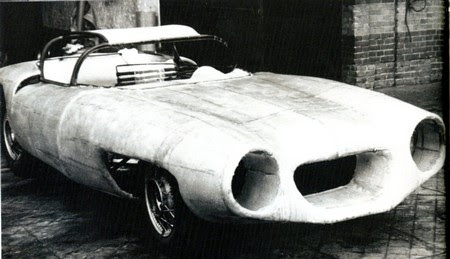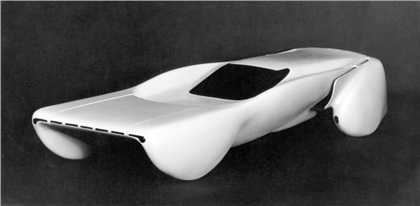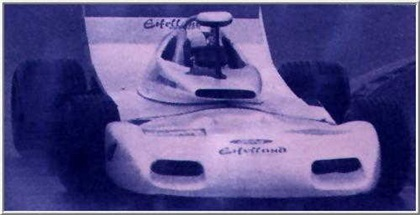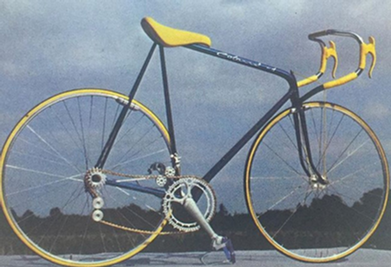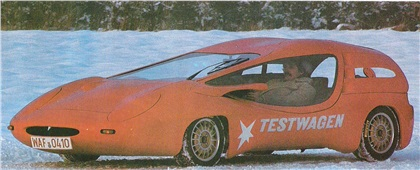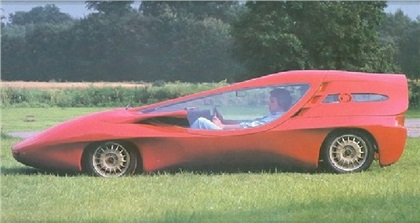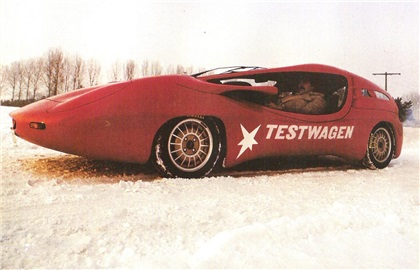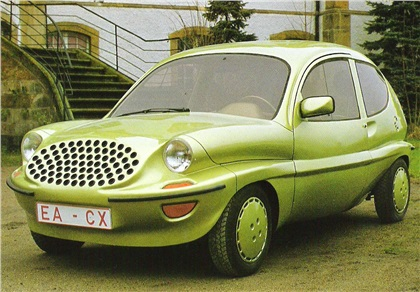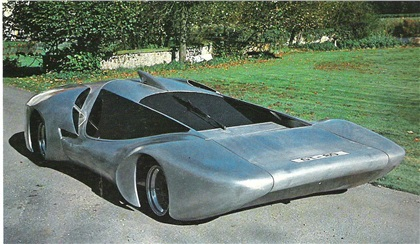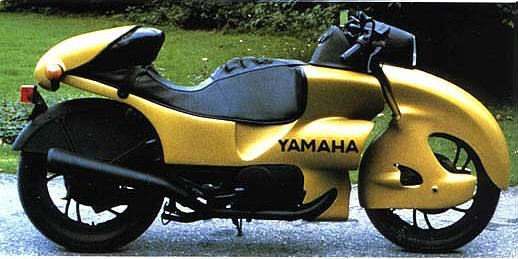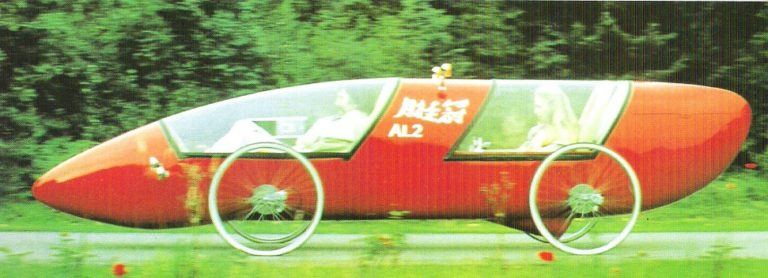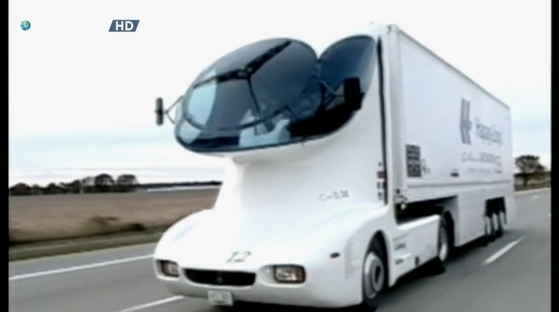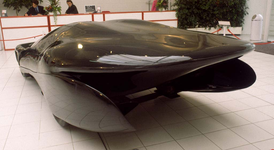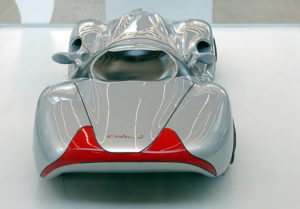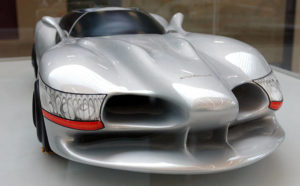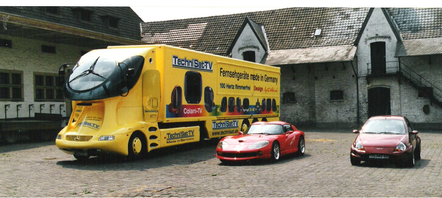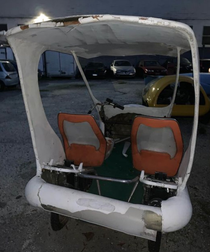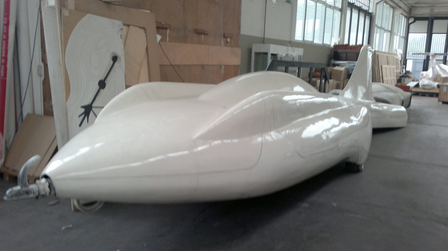Luigi Colani, a visionary German industrial designer, was renowned for his futuristic and unconventional approach to automotive design. His unique blend of aerodynamics, organic forms, and radical ideas transformed the car industry, pushing the boundaries of what vehicles could look like. In this blog, we'll take a journey through every car designed by Colani, from concept cars to road-ready masterpieces, exploring his bold and unforgettable creations.
1953 Simca by Colani
In 1953, Simca engaged Luigi Colani to help develop a revolutionary sports car featuring a body made entirely of synthetic materials. Colani, born in 1928 in Berlin, was a prominent figure in both the fields of art and aerodynamics. After completing his artistic studies, he pursued aerodynamics and began his career designing innovative car bodywork. The Simca prototype he worked on was notable for its use of plastic, marking it as one of the earliest European vehicles to feature an all-plastic body. Colani approached car design as a form of sculpture, and this is evident in Simca's design, which includes sculptural forms and functional elements such as large headlight openings that also served as air vents. This approach was parallel to contemporaneous developments in the U.S., such as the 1953 Corvette, which also experimented with plastic bodywork. The 1953 Simca by Colani stands out as a pioneering example of integrating aesthetic design with advanced materials technology.
1955 Fiat 1100 TV by Colani
The Fiat 1100 TV body designed by Luigi Colani in 1955 was a notable project in automotive design. The car's body, known for its distinctive sculptural qualities, was fitted onto a Fiat 1100 TV chassis, though Colani was responsible only for the bodywork and not the complete car. Despite some confusion about the exact year and specifics of the chassis used, the project highlighted Colani's early work with fiberglass and innovative design concepts.
1959 Abarth Alfa Romeo 1300 Berlinetta by Colani
The 1959 Abarth Alfa Romeo 1300 Berlinetta by Colani is a unique piece of automotive history. Originally an Abarth-Alfa Romeo 1000 GT Berlinetta, the car was dramatically transformed after a crash in 1959. Renowned designer Luigi Colani was tasked with creating a new body, resulting in a groundbreaking aerodynamic form that showcased his distinctive style. The rebuilt car was fitted with a larger 1300cc Alfa Romeo engine, enhancing its performance. While not a mass-produced model, the Abarth Alfa Romeo 1300 Berlinetta remains a significant milestone in automotive design and a testament to the visionary work of Colani.
1960s Colani GT
The 1960s Colani GT is a fiberglass roadster designed by Luigi Colani, based on a 1962 Volkswagen Beetle chassis. Produced between 1962 and 1967 (some sources cite between 1964 and 1968), around 360 units were sold. The car features Colani's distinctive organic styling and is equipped with Porsche 356 wheels and gauges. Notable for its high-quality finish, the Colani GT combines Colani’s innovative design with the reliability of the Beetle platform, offering a unique blend of aesthetics and performance.
1962 Lancia Aurelia-based Car by Colani
The 1962 Lancia Aurelia-based car designed by Luigi Colani is a unique creation likely built as a one-off. José Geraldo De AP Barreto Fonseca on Bubblemania.fr acknowledged that this vehicle represents a fascinating blend of Colani's innovative design aesthetic and the classic Lancia platform. Comment below if anything else is known about this rare piece of Colani's automotive history.
1963 BMW 700 by Colani
The 1963/4 BMW 700 by Colani is notable for being the world’s first vehicle with a self-supporting plastic monocoque body. Weighing 440 kilograms, this innovative sports car featured a 700 cc engine with 32 horsepower and achieved speeds of up to 200 km/h. Its streamlined design boasted a drag coefficient of 0.22. Despite attracting considerable attention and surprising BMW, the Colani-BMW 700 never entered series production and remains a unique prototype.
1965 Colani Volkswagen RS Racing Prototype
The 1965 Colani Volkswagen RS Racing Prototype was a striking concept car designed by Luigi Colani. It featured a lightweight polyester body with a height of just 95 centimeters and was intended to be built by the former German aircraft manufacturer Ernst Heinkel Flugzeugbau GmbH, known for producing plastic car bodies for the Porsche 904. The RS was showcased at the Frankfurt Motor Show in October 1965 and featured wing doors. Although the design allowed buyers to choose from a range of chassis, including options like the VW 1300 and Chevrolet Corvair Monza, the car remained a one-off prototype. The project was ultimately shelved when Heinkel shifted focus back to military vehicle production.
1967 C-Form Concept by Colani
Luigi Colani introduced his revolutionary "C-Form" concept in 1967. This scale wind tunnel model showcased an inverted wing-shaped vehicle body, setting a new standard for aerodynamic efficiency. Featured in Stern magazine, the C-Form inspired countless designers with its innovative four-wheel front layout and central cabin architecture. Later vehicles like the Le Mans 82 and BMW M2, though extravagant, echoed the C-Form's unique aesthetic, foreshadowing designs seen in cars such as the Corvette Indy and Porsche 959.
1969 Bizzarrini GT 5300 by Colani
The 1969 Bizzarrini GT 5300 by Colani was originally a standard Bizzarrini 5300 GT, but Luigi Colani found its design lacking in excitement. He modified the car to create a more striking and dynamic form, enhancing its visual appeal.
1970 C112 by Colani
In 1970, Luigi Colani presented the C 112 as an alternative supercar concept to Mercedes-Benz, which had unveiled the C111 central engine coupe with a Wankel rotary engine the previous year. Despite its unconventional design and color, the Colani C112 achieved remarkable aerodynamic efficiency with a drag coefficient (Cd) of just 0.2, significantly lower than typical sports cars of that era.
1970 Lamborghini Miura Le Mans Concept by Colani
The 1970 Lamborghini Miura Le Mans Concept, designed by Luigi Colani, reimagined the iconic Miura by blending its rear with a radically new, glider-inspired front end made of fiberglass. Colani, known for his biodynamic design philosophy, aimed to enhance the Miura's aesthetics with his signature organic shapes and streamlined forms. The prototype featured a unique cockpit where the driver and passenger lay almost horizontally, controlling the vehicle with a joystick. The front and rear wheels were linked by tie rods, allowing the car to articulate like a bus for cornering. Although the concept never raced at Le Mans, it made frequent appearances at car shows until it was sold on eBay in 2010 as a project car.
1972 Eifelland e21 Formula 1 Car by Colani
In 1972, the Eifelland Formula 1 team, founded by Günther Hennerici, transitioned to Formula One with a car redesigned by Luigi Colani. Based on the March 721, Colani's version featured his signature rounded aerodynamic shapes, an air intake in front of the driver to direct airflow around the cockpit, and a single rearview mirror. The white version is the pre-season Eifelland. Despite its innovative design, the car struggled with overheating and insufficient downforce. Rolf Stommelen, the team's driver, achieved two top-ten finishes at the Monaco and British Grands Prix. By the end of the 1972 season, the team refocused on Formula Three, and Hennerici retired after selling the team in 1974.
1972 Aerodynamic Race Car by Colani
In 1972, Luigi Colani designed an aerodynamic race car for the Eifelland Formula 1 team, featuring innovative design elements aimed at improving performance. This "Formula One Car of Tomorrow 2000" was noted for its futuristic aerodynamic features, intended to enhance speed and efficiency.
1973 Frog by Luigi Colani
The 1973 Frog by Luigi Colani is a motorcycle design study. Its design is characterized by its rationally molded polyethylene construction and hollow form. The prototype was finished with a striking red lacquer. The design's unique appearance reflects Colani's innovative approach to vehicle aerodynamics and form.
1973 Münch Motorcyle by Colani

The 1973 Münch Motorcycle by Colani is a motorcycle designed by Luigi Colani. It features a unique, aerodynamic design and is powered by a 1200 cc engine, which offers high performance. Known for its striking aesthetics and innovative engineering, the motorcycle reflects Colani's philosophy of blending form and function. This model is often celebrated for its distinctive appearance and advanced design concepts, making it a notable example of Colani's work in the automotive field.
1973 RFB / Grumman American Fanliner
In 1973, the RFB/Grumman American Fanliner, which featured input from industrial designer Luigi Colani, showcased a streamlined fuselage design while utilizing wings and a horizontal tail from the Grumman AA-5. The second pre-production prototype, registered D-EBFL, first flew on September 4, 1976, and was exhibited at the June 1977 Paris Air Show. It was powered by a 150 hp engine with relocated radiators and demonstrated a maximum speed of 251 km/h (156 mph) and a climb rate of 5.5 m/s (1,080 ft/min). The wingspan of this prototype was 9.60 m (31 ft 6 in). Despite its innovative design, production was not pursued as RFB shifted focus to the military Fantrainer.
1974 Colani GT2
The Colani GT2 was a personal car designed for Luigi Colani, representing a redesign of one of his earliest projects, the Colani GT. As a special version of a kit car based on the VW Beetle, the GT2 was a unique blend of classic design and modern technology. This vehicle, which Colani himself drove, featured a sports version of the VW Beetle chassis and was equipped with a world receiver and other extras for an enhanced driving experience. Colani took this car on a journey through the Indian subcontinent, with the GT2 often pictured in front of a pagoda in Sri Lanka. The car’s unique design and adventurous spirit evoke Jules Verne’s introduction of technology into exotic settings, and it remains preserved today.
1974 Ferrari 365 GTB4 Daytona
The 1974 Ferrari 365 GTB/4 by Luigi Colani is a notable one-off modification of the Ferrari Daytona. Colani, known for his distinctive biodynamic design approach, reimagined the classic Ferrari sports car with his signature rounded, aerodynamic style. This particular modification included a unique body redesign, distinguishing it from the standard Ferrari Daytona. Key changes involved alterations to the car’s bodywork to improve aerodynamics, though specific details of the modifications are less documented. The car remains a rare example of Colani's influence on high-performance vehicles, showcasing his ability to blend functional design with aesthetic innovation.
1976 Colani L'Aiglon Concept
The 1976 Colani L'Aiglon Concept was a unique roadster created by Luigi Colani, notable for its retro design. This one-off vehicle utilized the front axle from a Rolls-Royce Silver Cloud and an Opel Diplomat's V8 engine, complete with its camshaft. The car also featured a Rolls-Royce radiator and an Opel GT roof. Debuted in white at the 1976 Geneva Motor Show, the L'Aiglon's design resembled a lengthened Auburn Boat-tail Speedster with prominent exhaust pipes and flared wheel arches. Its luxurious interior complemented its striking exterior.
1976 Concept Bike by Colani
The 1976 Colani Concept Bike, designed by Luigi Colani, was an innovative prototype aimed at creating a sleek, lightweight bicycle with cutting-edge performance. Reflecting Colani's futuristic design philosophy, the bike was crafted to be both elegant and fast, surpassing the performance of contemporary models. Although its exact speed remains unknown, the Colani concept bike is now a highly sought-after collectible among enthusiasts.
1976 Volkswagen Turbo Polo by Colani
The 1976 Colani Volkswagen Turbo Polo was an experimental prototype designed to push aerodynamic boundaries. Based on the first-generation VW Polo, it featured an aerodynamic body designed by Luigi Colani and was equipped with a turbocharger to enhance performance. The car aimed to set a land-speed record for its class.
1976 VW Polo by Colani
The 1976 VW Polo by Luigi Colani was a notable prototype that showcased Colani's innovative aerodynamic design. Based on the first-generation VW Polo, this modified version featured a highly streamlined body to enhance aerodynamic efficiency. Colani's design aimed to improve the car's performance and fuel efficiency, reflecting his signature approach to creating fluid, organic shapes in automotive design. Notably, it had an add-on trunk for additional storage, VW logos placed throughout, and aerodynamic wheels.
1977 Volkswagen Prototype by Colani
In 1977, Luigi Colani designed a Volkswagen prototype intended to be a successor to the Beetle, positioned between the Polo and Golf in size. The design, which featured a distinctive frog-like appearance, was an experimental hatchback that reflected Colani's unique aerodynamic and artistic vision. Despite its innovative and unconventional design, Volkswagen was not interested in the prototype, and it never went into production.
1977 Colani GT70 Sportscar Prototype
Information on the 1977 Colani GT70 Sportscar Prototype is scarce. If anything is known, please comment below. Additional photos are in this Story Cars article.
1977 Colani-BMW 320i
The 1977 Colani-BMW 320i was a concept car designed by Luigi Colani, known for his organic and futuristic designs. This model was based on the BMW 320i, a popular car from BMW's 3 Series lineup. Colani's version featured radical aerodynamic modifications, including a distinctive, streamlined body with a low drag coefficient. The concept was intended to showcase advanced design and aerodynamics, emphasizing Colani's vision of the future of automotive styling. However, like many of his other designs, it remained a unique prototype and did not enter mass production.
1978 Colani Hovercraft

The 1978 Colani Hovercraft was a streamlined four-seater designed by Luigi Colani, reaching impressive speeds for its class. Powered by an Audi engine and propelled by two belt-driven propellers, the hovercraft achieved a world record speed of 182.5 km/h in Florida. With a maximum speed of 150 km/h, this design was a testament to Colani's commitment to aerodynamics and performance across diverse vehicles.
1978 Colani New RS
The 1978 Colani New RS was a groundbreaking sports car concept by Luigi Colani, notable for its aerodynamic design and plastic body, serving as a precursor to the aluminum-bodied Ford GT80. Initially sketched in 1967 and later developed into a wind tunnel model and full-scale mockup by 1977, the New RS featured a unique front-end design that channeled airflow over the body rather than obstructing it. This design aimed for a target drag coefficient of 0.24, significantly reducing air resistance and improving downforce, showcasing Colani's innovative approach to automotive design and his "C-Form" concept that evolved over a decade.
1978 Colani Truck 2001
The 1978 Colani Truck 2001 represented a significant shift in heavy-duty vehicle design, brought to life by the famed Italian avant-garde designer Luigi Colani. Debuting at the IAA Truck Show in Frankfurt, the truck featured a futuristic design aimed at reducing aerodynamic drag and improving fuel efficiency. This truck’s design included a streamlined cabin with a round windshield and a rotary three-beam wiper, accessing the interior by lifting the cabin up. Its unique beak-shaped silhouette aimed to achieve a drag coefficient of 0.4, ultimately reducing fuel consumption by 25%. Colani later established a studio in Switzerland, where he developed a second-generation truck based on a Mercedes-Benz 1729 chassis. The redesigned model, featuring a 240-hp engine and an aerodynamic dome, achieved a drag coefficient of 0.38 and a fuel consumption rate of 26.7 L/100 km. Despite the prototype's innovations and its successful tour across the USA, it failed to garner interest from major manufacturers and was eventually sold to the German company Bardusch. Nonetheless, the 2001 L. Colani Truck is remembered as a visionary leap in truck design, integrating aerodynamic efficiency with enhanced safety features, such as a movable driver's compartment and digital instrumentation, years ahead of its time.
1978 Ford GT80 by Colani
The 1978 Ford GT80 by Luigi Colani was an advanced development of the Ford GT40, designed for Le Mans with Colani's distinctive "C-Form" aerodynamic style. Colani, an engineer in aerodynamics and an artist, created a unique prototype with a streamlined design similar to racing wing cars, using a monocoque aluminum chassis built by Tiga Racing Cars. The GT80 featured a Ford Cosworth V6 engine with 298 kW, Formula One-grade brakes and suspension, and a cutting-edge aerodynamic design with a claimed drag coefficient of less than 0.2. Despite its innovative features, including an airbag and video camera for rearview, the car never entered production. Only three variants were made: one with a plastic body and two with aluminum bodies.
1978 VW Polo Concept by Colani
The 1978 VW Polo Concept Design by Luigi Colani was an innovative attempt to create a successor to the Volkswagen Beetle, designed to sit between the VW Polo and VW Golf in the product lineup. The concept showcased Colani’s signature aerodynamic styling, with a sleek, rounded body that minimized air resistance, aiming to improve fuel efficiency and performance. Despite its futuristic appeal and efficient design, the prototype did not interest Volkswagen and remained a unique showcase of Colani’s avant-garde approach to automotive design.
1979 Colani Sea Ranger
The 1979 Colani Sea Ranger, designed by the prolific German artist and designer Luigi Colani, was a unique amphibious vehicle built on the chassis and running gear of a Mercedes Unimog, constructed by Thyssen in Germany. Its watertight, science-fiction-inspired shell and its absurd, yet highly functional design, set it apart from other vehicles of its time. Key features included an open interior with large angled windows for 360-degree views, a side ladder for roof access, a powerful radio antenna, and a swiveling rear fishing seat reminiscent of 1970s egg chairs. Debuting at the 1980 Hanover Fair, the Sea Ranger drew a curious crowd but failed to garner enough interest for mass production, leaving it as a one-off housed at the Colani Design Museum.
1979 Study for BMW by Colani
The 1979 Study for BMW was a concept by Luigi Colani that proposed a radical new design for the BMW 5 Series. Colani's concept featured a streamlined and organic body shape with smooth curves and integrated headlights, highlighting his vision of aerodynamics and futuristic aesthetics. This design was a bold departure from the traditional BMW styling, aiming to redefine automotive aerodynamics and visual appeal.
1980 Colani GT90 'Le Mans 82'
The 1980 Colani GT90 'Le Mans 82' was a sports prototype based on Luigi Colani’s earlier 1978 Ford GT80 concept. Designed for the 1982 24 Hours of Le Mans, it was initially proposed to 1980 Le Mans winner Jean Rondeau, who declined, considering the project too ambitious. Following this, Colani repurposed the GT90 into a BMW M2 concept, presenting it at the 1981 Salon de l'Automobile as the successor to the iconic BMW M1. The GT90 was characterized by its futuristic design and was powered by a BMW engine, representing Colani’s vision for high-performance, aerodynamic vehicles.
1980 Yamaha Alula Motorcycle by Colani
The 1980 Yamaha Alula was a running model designed by the German designer Luigi Colani. Introduced in 1981, the Alula showcased Colani's unique aerodynamic approach, emphasizing sleek, futuristic lines and innovative design concepts.
1981 BMW M2
The 1981 BMW Colani M2 was a one-off concept designed by Luigi Colani, a famous German industrial designer, as an alternative to Giugiaro’s BMW M1. The car featured no drivetrain, created purely as a design exercise with no intent for production. Colani initially proposed the design to Le Mans driver Jean Rondeau. Released at the 1981 Paris Motor Show, the M2 concept showcased a bold aerodynamic design and was powered by a twin-turbo V8 engine. Despite its impressive styling, it remained a singular unit.
1981 Mercedes “G” by Luigi Colani
The 1981 Mercedes "G" by Luigi Colani is an extremely rare, one-off modification of a Mercedes 280GE. Designed by the renowned industrial designer Luigi Colani, the vehicle was transformed in 1981 and outfitted with a powerful 5.6L V8 engine by AMG. Though visually unconventional, it stands out as one of the most unique G-Wagons ever built. With only 85,000 kilometers on it, the car gained attention in 2004 when it was put up for sale, becoming eligible for import to the U.S. without regulatory hassles due to its age.
1981 Colani 2CV Experimental I
The 1981 Colani 2CV Experimental I was a record-breaking fuel-efficient vehicle based on the Citroën 2CV. Luigi Colani designed this experimental car to consume only 1.7 liters of fuel per 100 kilometers. The car retained the original 2CV engine and chassis but featured an aerodynamic, wing-shaped body and low rolling resistance Goodyear tires, dramatically improving its fuel economy. This innovative design showcased Colani's commitment to efficiency while using minimal resources.
1981 Colani 2CV Experimental II
The 1981 Colani 2CV Experimental II was an advanced aerodynamic concept designed by Luigi Colani, showcased during the “Futurama” exhibition celebrating 50 years of his work. Inspired by the fluid shapes of "aquatic dragons," the car achieved a remarkable drag coefficient of Cx=0.19. Building on the foundation of the Citroën 2CV, this experimental vehicle highlighted Colani's futuristic approach to automotive design, focusing on extreme efficiency and streamlined forms.
1981 Colani 2CV Experimental III
The 1981 Colani 2CV Experimental III featured an innovative design with ball wheels on the front axle, allowing for maneuverability in all directions. This concept was an experimental evolution of the Citroën 2CV, showcasing Luigi Colani's unconventional approach to automotive design by enhancing functionality and efficiency.
1982 Colambo Countach Concept by Luigi Colani
The 1982 Colambo Countach Concept by Luigi Colani, applied his innovative approach to ground-effect aerodynamics. Colani's concept aimed to channel airflow under the car as a controlled central stream, guided by a "central drift" and framed by downward-curving lateral wings in an inverted "C" shape. This design, intended to reduce lift and enhance stability at high speeds, exemplifies Colani’s aerodynamic philosophy and emphasis on ground effect. His "Colambo Project" reinterpreted the Lamborghini Countach with these principles, showcasing a radical approach to aerodynamics that became a defining element across many of Colani's automotive creations.
1982 Tandem 4-Wheeled Bike by Luigi Colani
The 1982 Tandem 4-Wheeled Bike by Luigi Colani was a fully enclosed, foot-pedal-powered vehicle with a streamlined design. Painted in a striking red, it could seat two passengers, offering an innovative and eco-friendly transportation concept that combined Colani’s signature aerodynamic styling with human-powered mobility.
1982 Trike by Luigi Colani
The 1982 Trike by Luigi Colani featured a unique design with three main wheels and a fully enclosed cabin. It included a detachable compartment at the back with two wheels, designed to carry a toddler and convertible into a stroller. The trike also sported a prominent headlight on the front, emphasizing both practicality and Colani's distinct futuristic aesthetic.
1983 Mazda Le Mans Prototype
The 1983 Mazda Le Mans Prototype by Luigi Colani was a radical design concept powered by a four-rotor Wankel engine, initially proposed to produce 950 hp and capable of reaching speeds up to 235 mph. Colani, who had relocated to Tokyo and began collaborating with Mazda, envisioned this car for the prestigious Le Mans race. At a later stage, the plan evolved to use a 4-chamber Wankel rotary engine capable of 960-1400 hp. However, despite its ambitious design, the prototype remained a life-size model and never saw actual racing.
1985 Bio Concept Yamaha FC-1 by Colani

The 1985 Bio Concept Yamaha FC-1 was a collaboration between Yamaha’s “man-machine” philosophy and Luigi Colani’s biodesign, emphasizing a human-centered approach. Presented at the Tokyo Motor Show, the FC-1 concept integrated fluid, organic shapes to improve aerodynamics, ensuring airflow bypassed the rider. Colani’s signature focus on fluid dynamics was evident, as the design aimed to enhance comfort and reduce wind resistance, blending functionality with a futuristic, ergonomic look.
1985 Mercedes-Benz Le Mans Prototype
The 1985 Mercedes-Benz Le Mans Prototype by Luigi Colani was an ultra-aerodynamic design intended for the iconic endurance race. Despite its innovative approach and striking appearance, this prototype was never raced. It was part of Colani’s continued exploration of Le Mans concepts, following a similar Mercedes Le Mans design from 1970. Like many of Colani’s radical ideas, this prototype remained an ambitious project without reaching competitive motorsport.
1986 Colani-Egli MRD-1
The Colani-Egli MRD-1 was a high-performance motorcycle designed to set land speed records. It featured a turbocharged, nitrous-enhanced engine producing 320 hp. The MRD-1 achieved a notable milestone by breaking the World Land Speed Record for 10 km from a standing start with a speed of 170.26 mph (274.58 km/h), surpassing the previous record held by the Honda ELF, ridden by Ron Haslam, which was 265.4 km/h. The MRD-1’s top speed reached 330 km/h.
1987 Porsche by Luigi Colani
The 1987 Porsche project by Luigi Colani involved modifying a Porsche 959 to enhance its aerodynamic design. Its roof design was similar to the 1976 Volkswagen Turbo Polo and the 1963 BMW 700 by Colani, and the proportions resembled those of the 1978 Ford GT80.
1987 Lada Gorbi
The 1987 Lada Gorbi, designed by Luigi Colani, was an all-terrain vehicle built on a Lada platform for desert rallies. It featured large wheels, high ground clearance, 4WD, and 4-wheel steering. The vehicle included special reclining seats for driver comfort and had an estimated top speed of 200 km/h, powered by a 200 hp engine.
1988 Corvette Charisma
The 1988 Colani Corvette Charisma, initially white and designed in early 1988, showcased Luigi Colani's unique Bio-Design approach. The vehicle underwent several transformations before arriving in the US to attempt a land speed record at Bonneville. Although it was redesigned for the Automorrow tour, it wasn't completed in time.
1989 Colani UTAH 1
In 1989, Luigi Colani brought 12 of his UTAH vehicles to the Bonneville Salt Flats for Automorrow ’89, aiming to set new speed records. Among these, the UTAH 1, a high-speed bike designed by Colani's assistant Sébastien Kummer, stood out. Colani used the success and visibility of this venture to further his independence as a designer. During the trip, he shared his insights with designers at Ford, students at the Art Center College of Design, and met with visionaries like Georges Lucas and Steven Spielberg.
1989 Colani UTAH 2
The UTAH 2, a high-speed bike designed by Colani’s assistant Sébastien Kummer, featured double front pedals and a Fichtel & Sachs 30cc two-stroke air-cooled engine producing 2.5 horsepower. The rear-mounted engine could be quickly started with a rope to enhance muscle power on inclines.
1989 Colani UTAH 3
The UTAH 3, a high-speed bike designed by Colani’s assistant Sébastien Kummer, was built to exceed the existing speed record of 104.64 km/h.
1989 Colani UTAH 4
The 1989 Colani UTAH 4 was a high-speed bike designed by Colani's assistant, Sébastien Kummer. It featured a Swiss Schlimmer V8 engine with 47 cm³ camshafts, mounted transversely at the rear of the bike, providing additional power to the cyclist, who was positioned facing forward on the belly.
1989 Colani UTAH 5
The 1989 Colani UTAH 5 was another high-speed bike, reportedly equipped with an 80 cc engine.
1989 Colani UTAH 6
The 1989 Colani UTAH 6 was a sports coupe with a mid-engine layout, using a centrally mounted VW Golf (Rabbit) engine. An identical white version also exists.
1989 Colani UTAH 7
The 1989 Colani UTAH 7 was an aerodynamic racing car with a CO2 engine, notable for its unmodified mechanics and body enhancements. It set a record for the lowest fuel consumption over 100 km at 1.75 liters, thanks to its 50 cc engine and an exceptionally low drag coefficient of Cx 0.18.
1989 Colani UTAH 8
The 1989 Colani UTAH 8 featured a turbocharged BMW K-100 engine, with 150 hp from 1000 cm³, and a Lotus Super Seven transmission paired with a BMW gearbox. It boasted a low height of 90 cm, weighed just 550 kg, and utilized a carbon fiber chassis.
1989 Colani UTAH 9
The 1989 Colani UTAH 9 was based on the Citroën 2CV but featured an electric motor, making it unique among the UTAH series.
1989 Colani UTAH 10
The 1989 Colani UTAH 10 achieved a top speed of 281.6 km/h. It was powered by a 500 cc Honda racing engine producing 148 hp.
1989 Colani UTAH 11
The 1989 Colani UTAH 11 was designed for high-speed performance on the salt flats. It featured a turbocharged 1,300 cc four-cylinder engine. Initially, it had only two wheels, but it was later modified into the UTAH 13 with an additional extended side wheel for improved stability.
1989 Colani UTAH 12
The 1989 Colani UTAH 12, also known as the Colani Truck 2001, was a second-generation version of Colani's streamlined truck design. It featured a reduced drag coefficient of 0.38. Despite its advanced aerodynamics, it did not set any records on the salt flats. The truck gained attention during its promotional tour in the USA and later returned to Europe, where it was repainted in blue. Known for its bold design, it was part of Colani's ongoing experiments to revolutionize commercial vehicle aesthetics and efficiency.
1989 Colani UTAH 13
The 1989 Colani UTAH 13, designed for speed and acceleration on the salt flats, was equipped with a turbocharged 1300 cc 4-cylinder engine. It is believed that the UTAH 11, initially with only two wheels, was modified to become the UTAH 13 with the addition of an extended side wheel.
1989 Ferrari Testa d’Oro by Colani
The 1989 Ferrari Testa d'Oro by Luigi Colani is a one-off, 700hp-plus car based on a Ferrari Testarossa. Designed for speed records at Bonneville, it features Colani's signature aerodynamic, organic shape, though its low front spoiler makes road use challenging. The twin-turbo engine, rebuilt by German tuner Lotec, helped the car win its class. It would be remodeled in 1992.
1989 Ford Prototype by Colani
The 1989 Ford Prototype by Luigi Colani featured a turbocharged 3.5-liter Ford V8 engine and set a speed record of 407 km/h (252.9 mph). Since its creation, the prototype has undergone three different paint jobs.
1989 Larel Electric Car by Colani
The 1989 Larel Electric Car by Luigi Colani was an experimental vehicle that showcased his futuristic design approach, focused on aerodynamics and efficiency. As an electric car, it reflected Colani’s interest in environmentally friendly transportation long before such concepts were mainstream. The vehicle had a sleek, streamlined shape to minimize drag and enhance battery efficiency. However, details about its specific performance, technical specifications, and its impact on the industry are limited, making it one of Colani's lesser-known projects.
1990 Mercedes du Mans by Colani

The 1990 Mercedes Du Mans was an innovative concept car designed by Luigi Colani, showcasing his distinctive approach to automotive aesthetics and performance. With an emphasis on aerodynamics, the Du Mans featured a sleek, streamlined design aimed at maximizing speed and efficiency on the racetrack. Colani's vision incorporated cutting-edge shapes and materials to enhance the vehicle's performance, reflecting his belief in the harmony of form and function.
1990 Stingray Group C
The 1990 Stingray Group C by Luigi Colani was a study for a record-breaking vehicle inspired by the grand tradition of Le Mans racing. Its design, shaped like a manta ray, showcased Colani's signature focus on aerodynamics. The vehicle’s body was engineered to generate two tonnes of downforce purely through its shape, eliminating the need for additional fins. This innovative approach to aerodynamics reflected Colani’s fascination with organic forms and extreme performance. The Stingray is now part of the permanent collection at the Centre Pompidou in Paris.
1991 Colani Corvette Prototype Racer
The 1991 Colani Corvette Prototype Racer was designed by Luigi Colani to break land speed records. After being displayed at the 1993 SEMA show, it aimed to set records at the Bonneville Salt Flats. On August 23, 1995, driven by Mike Strasburg, it achieved an average speed of 230.928 mph at Bonneville.
1991 Colani Volvo Sport
The Luigi Colani-designed Volvo Sport, built before the Mercedes McLaren in 1991, showcases Colani's unique aerodynamic design principles. His vision for this Volvo model reflects his futuristic approach to automotive design, emphasizing streamlined forms that reduce drag and enhance performance. A notable photograph by Jun Sato captures the essence of this sports car, displaying Colani’s distinctive style well before his involvement with the Mercedes McLaren project.
1990 Eicher Colani Tractor (656 VAC)
The 1990 Eicher Colani Tractor (656 VAC), designed by renowned industrial designer Luigi Colani, featured his signature rounded, organic shapes, making it look like a futuristic farm vehicle straight out of The Jetsons. This narrow vineyard tractor, based on Eicher's 656 VAC model, sported an egg-shaped design that emphasized aerodynamics, though the need for such efficiency in slow-moving farm equipment was questionable. Its cramped cab and lack of rearview mirrors made it impractical for real-world farming, positioning it more as a provocative design statement than a functional tool.
1992 Ferrari Testa d’Oro by Colani
The 1992 Lotec Testa d'Oro, designed by Luigi Colani and based on a Ferrari Testarossa, was created to break speed records. Powered by a Ferrari twin-turbo flat-12 engine producing 750 bhp, it reached a top speed of 351 km/h.
1993 Colani Carisma Spyder
In 1993, Luigi Colani designed the Carisma Spyder, an aerodynamic concept based on the Corvette ZR1. This futuristic car, primarily white and transparent, featured Colani's signature flowing lines and a sleek, spoiler-like rear. Its interior, finished in black and yellow leather, had an organic feel with unique elements like a spokeless steering wheel. Powered by a 380 hp Corvette V8, a custom ultralight version hit 251 mph at the Bonneville Salt Flats, showcasing Colani’s blend of art and performance. The Carisma Spyder remains a bold example of his visionary automotive design.
1993 Hymer Colani Design
The 1993 Hymer Colani Design is a unique camping car designed by Luigi Colani, blending his signature aerodynamic style with the practicality of a motorhome. Exhibited at the Hymer Museum in Bad Waldsee in 2021, this design features a sleek, futuristic exterior with rounded shapes and an innovative approach to aerodynamics, aimed at reducing drag and improving fuel efficiency. The interior is spacious and designed with functionality in mind, offering comfort for long trips. This concept reflects Colani's ability to combine aesthetics with practical design elements, making it stand out in the realm of camping vehicles. One source claims it was designed in 1998. Watch a video of it here.
1995 Mercedes-Benz Vision 2005 Truck
The 1995 Mercedes-Benz Vision 2005 Truck was Luigi Colani's third concept truck, presented at the Frankfurt Motor Show. Built on a Mercedes-Benz 1844LS chassis with a 435-horsepower turbodiesel engine, it featured a reduced drag coefficient of 0.32 and advanced safety systems like ABS and ESP. The truck introduced side doors for easier cabin entry and aerodynamic pylons that directed airflow while supporting the glass dome cabin. Its cabin suspension system enhanced ride comfort, a notable improvement over Colani’s previous designs. In 1997, a more aggressive version was created for TechniSat on the same base.
1996 Colani Horch Mega-Roadster
The 1996 Colani Horch Mega-Roadster was Luigi Colani’s vision of reviving the luxury German brand, Horch. Featuring a V16 engine and Colani's signature wavy hood design, it was presented as a sleek, elegant coupe with butterfly doors. The car included a Horch emblem and a sculpted figure on the hood, embodying Colani's bold design aesthetic. The prototype was unveiled at the Essen Motor Show in 1996.
1998 Ford Ka
In 1998, Ford collaborated with Luigi Colani to create a more aggressive version of the Ford Ka, showcased at the Essen Motor Show. Colani's design featured an aerodynamic body kit and new Schmidt Revolution alloy wheels. Powered by a 1.2L Ford Endura-E engine, the car produced 60 hp, with a top speed of 158 km/h and 0-100 km/h acceleration in 15.1 seconds. The design impressed the public, leading to the production of 200 units sold through the Cologne R&S Mobile dealer.
1999 Colani Dodge Viper
The 1999 Dodge Viper designed by Luigi Colani was a radical remodel of the original Dodge Viper, incorporating Colani's signature futuristic and aerodynamic design principles. Known for his "bio-design" approach, Colani reshaped the Viper with smooth, flowing curves and a more organic aesthetic. The remodel emphasized reducing drag and enhancing performance while maintaining the aggressive stance of the original Viper.
1999 Colani Mamba
The 1999 Colani Mamba is a unique prototype crafted by renowned designer Luigi Colani, known for his striking and futuristic car designs. This particular model, although just a rolling body and not functional, showcases Colani's signature "bio-design" approach with its smooth, organic curves. The Mamba is a piece of automotive art and can be viewed in a showroom in De Lier. It serves as an example of Colani’s visionary design, often displayed in museums worldwide.
2000 Colani Golf Car
The 2000 Colani Golf Car, a futuristic electric golf cart designed by Luigi Colani for a golf course in China, showcases his signature blend of sleek, organic design and functionality. In October 2019, this unique vehicle was auctioned on Catawiki (Lot 29764203) with an expert estimate of €8,500 to €12,500, attracting attention for its rarity and Colani's distinctive approach to electric vehicle design.
2000 Camion DAF Aero 3000
In 2001, Luigi Colani, known for his bold and aerodynamic designs, introduced the DAF Aero 3000 Truck, aiming to revolutionize truck design. Based on the DAF 95 XF chassis with a 430-horsepower engine, the Aero 3000 featured Colani’s signature streamlined, futuristic look, including a three-volume structure, air intake, and side rearview cameras alongside traditional mirrors. Despite its innovative features, the truck market was not ready for such a radical departure from standard designs. While it didn't achieve commercial success, the Aero 3000 later served as a show truck for a mineral water company, continuing to reflect Colani's visionary approach.
2001 Colani Trabant
In 2001, Luigi Colani introduced a design modification for the existing Trabant, offering a bold front-end conversion kit rather than a new car. The kit featured a sloping windshield, integrated headlights, and a rounded hood, giving the 2001 Colani Trabant a futuristic, aerodynamic look. While visually striking, it prioritized aesthetics over practicality, and its impact on performance is unclear.
2001 Colani Shanghai
The 2001 Colani Shanghai was a futuristic microcar concept designed by Luigi Colani, known for his bold and unconventional creations. Featuring a bubble-like transparent canopy, streamlined body, and scissor doors, the design aimed for maximum aerodynamics and visual impact, though practicality and safety were concerns. While unconfirmed, it was likely envisioned with a small electric or hybrid powertrain to suit urban environments.
2002 Colani Spitzer-Silo Truck
The 2002 Colani Spitzer-Silo Truck was inspired by the success of the previous year's DAF Aero 3000 Truck and backed by the German tank manufacturer Spitzer-Silo. Colani created this impressive truck for the company's 50th anniversary, using a Mercedes-Benz Actros model with a 340 hp engine. This design featured a round-section semi-trailer and a streamlined body that reduced drag to a remarkable coefficient of 0.3, leading to lower fuel consumption of 20.91 liters per 100 km. While Colani was a design genius, his futuristic trucks, like this one, remained unproduced, hinting at what trucks might look like in the future.
2002 Colani Trabant Speedster
In 2002, Luigi Colani introduced the Trabant Speedster, a more radical modification of his earlier 2001 Trabant front-end conversion kit. The Speedster transformed existing Trabants into two-seater, open-top cars, possibly relocating the engine to improve handling. However, information about the Speedster is limited and unverified, with no confirmed production or widespread availability. Its existence remains largely speculative, based on unconfirmed online sources.
2003 Colani Shark
The 2003 Colani Shark is a unique design study created by Luigi Colani in collaboration with Reinhard Stahl. This one-of-a-kind vehicle is based on an Opel Speedster and features the standard 2.2-liter engine, producing 108 kW (147 hp).
2004 Colani LSR 700

The 2004 Colani LSR 700 was a land speed record prototype built by Luigi Colani, who had long pursued designs aimed at pushing limits in both aerodynamics and speed. This ambitious, futuristic vehicle was powered by a BMW-derived V12 engine producing around 700 horsepower, which inspired its "LSR 700" name. Designed with an ultra-low drag coefficient to minimize air resistance, the streamlined body emphasized Colani’s unique biomorphic aesthetic, similar to his previous speed record vehicles showcased at the Bonneville Salt Flats. Colani's focus on extreme aerodynamics with the LSR 700 highlighted his dedication to record-breaking designs, though like some of his other conceptual vehicles, it never officially broke a record.
2004 Colani-designed Mitsubishi 3000GT/Dodge Stealth
In 2004, Luigi Colani created a design based on the Mitsubishi 3000GT, also known as the Dodge Stealth in the U.S. This reimagining involved his signature aerodynamic and biomorphic styling, significantly altering the car’s body with a streamlined, futuristic look. Colani’s modifications were typical of his work, with a focus on reducing drag and creating a unique, organic shape that stood out from the original angular design of the 3000GT/Stealth. Learn more about the 2004 Colani-designed Mitsubishi 3000GT/Dodge Stealth.
2006 Colani Street-Ray

The 2006 Colani Street-Ray is a single-seater prototype with a unique, futuristic design focused on enhancing handling and road performance. Its low center of mass and distinct geometric shape improve road-holding and enable fast cornering. The car features a broad front axle, twice the width of the rear, designed to optimize stability and handling on the road. Its advanced aerodynamics further contribute to its appeal, making it ideal for enthusiasts who value both innovative design and exhilarating driving dynamics.
2006 Colani Yellow Egg

The 2006 Colani Yellow Egg was a conceptual city car embodying Luigi Colani's vision of compact, efficient urban transportation. This design featured a striking, egg-like shape optimized for aerodynamics, aimed at reducing fuel consumption and emissions in city driving. Its small, rounded body was intended to enhance maneuverability in crowded urban areas while providing a distinct aesthetic appeal. The Yellow Egg’s minimalistic, streamlined form reflects Colani’s commitment to functional, organic design.
2006 Colani SuperTruck

The 2006 Colani SuperTruck was another of Luigi Colani's groundbreaking, streamlined truck designs, sponsored by Siemens. This concept truck, based on the Mercedes-Benz Actros, featured extreme aerodynamics, with the cabin integrated directly into the trailer. The truck’s drag coefficient was an impressive 0.3, with highway fuel consumption reduced to just 20 liters per 100 kilometers. Its unique design included an aircraft-like forward nose that slid forward to provide access to the cabin, and steering was controlled by an autonomous trolley system beneath the cabin. The SuperTruck showcased Colani’s futuristic vision for energy-efficient, aerodynamic heavy vehicles.
2007 Aerodynamics Study 2-Seater Bicycle

The 2007 Aerodynamics Study 2-Seater Bicycle by Luigi Colani was a conceptual design focused on optimizing aerodynamics for increased cycling efficiency. This tandem bicycle featured an enclosed body with an elongated, sleek shell to reduce air resistance. Its low-slung, streamlined form was designed to minimize drag while accommodating two riders, aligning with Colani's signature bio-design aesthetic. The concept underscored Colani's commitment to integrating aerodynamic principles across a wide range of vehicles, from bicycles to trucks.
2007 Colani Pierce-Arrow

The 2007 Colani Pierce-Arrow represents a revival of the historic Pierce-Arrow brand, initiated by automotive enthusiasts in Switzerland in 2006, led by Olaf vom Heu and Reinhard Krätzig. Designed by renowned industrial designer Professor Luigi Colani, the new Pierce-Arrow features a modern 10-liter, 24-cylinder engine, combining performance with luxury. Each vehicle is customizable, allowing owners to choose from a range of body styles, from classic to futuristic, making every Pierce-Arrow by Colani a unique creation. This project continues the legacy of exclusivity and tradition associated with the Pierce-Arrow name, catering to the desires of its discerning clientele.
2011 Colani Aerodynamic Race Car

The 2011 Colani Aerodynamic Race Car, displayed in 2011 (referred to as the "F Dream" in two sources) at the Triennale Bovisa in Milan. While specific details about the vehicle's design and performance are limited, it reflects Colani's signature style of incorporating advanced aerodynamics into automotive design.
2015 Supercar T600

The T600, designed by Luigi Colani in 2015, aimed to achieve an impressive speed of 600 km/h. This supercar features a unique aerodynamic design that emphasizes performance and efficiency. Colani's vision for the T600 reflects his signature style of blending cutting-edge technology with artistic flair, making it a notable entry in the world of high-speed vehicles.
2018 Ravana Truck by Colani

The 2018 Ravana Truck represents the seventh version of a luxury tractor designed by Luigi Colani. This model features a camping car trailer, combining functionality with comfort for long-distance travel. Colani's design emphasizes both aesthetic appeal and aerodynamic efficiency, making it suitable for modern luxury camping needs. The Ravana Truck showcases Colani's signature approach to blending innovative design with practical utility.
2019 Minibus (Camping Car) by Colani

The 2019 Minibus is the eighth version of a luxury tractor designed by Luigi Colani, featuring a camping car configuration. This model was unveiled at an expo and includes advanced features such as a rounded shape, a three-frame wiper system, and an ultra-wide viewing angle of 270°. The RV measures approximately 5.9 meters long, 2.2 meters wide, and 2.8 meters high, making it spacious and comfortable for users. Specifically tailored for the Chinese market, the Colani VR emphasizes both innovative design and practicality for modern travelers.
The vehicles below remain a mystery. Comment below if more is known.

Only once mentioned online by a reputable source, the Luigi Colani Design Museum posted this image in a deleted tweet along with the quote, " If it's not sexy, it's not a good design." It was also mentioned on The Vintagent with the caption "Erotic, feminine forms applied to wheeled vehicles…a design study for a motorcycle."
This Colani design is showcased in a single online photo, where it is positioned next to Colani's 1973 Frog. It is believed to have been created in 2004 and may potentially be a go-kart.
The images above resemble a Jet Car or record car with a trailer attachment in front, significant rear overhang, and features only two wheels positioned in the center. It was exhibited at Nancy Hall, and in the background of a photo, Luigi Colani's truck can be seen parked outside. One online source mentions its construction being in 2007. Further details about its name or specific purpose remain unknown, but there has been some progress in identifying its nature as a potential trailer, possibly used for gliders.
It is a conversation starter on many Reddit threads; however, there is no definitive information outside it constantly being compared to a Batmobile.







